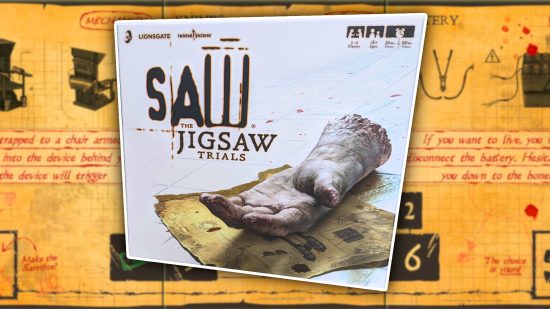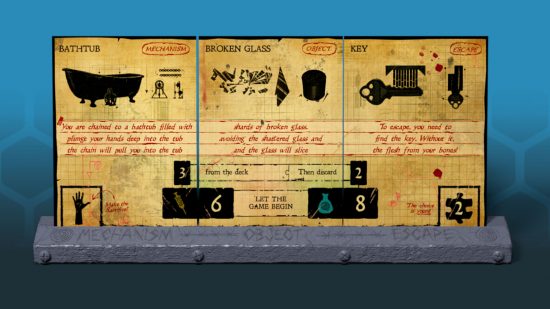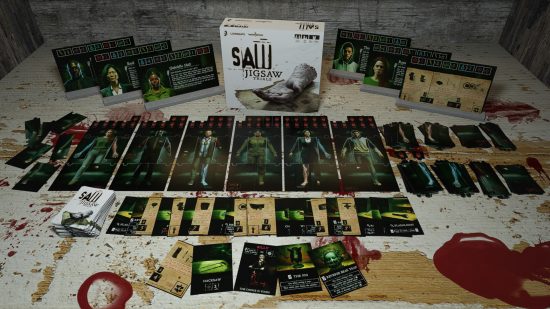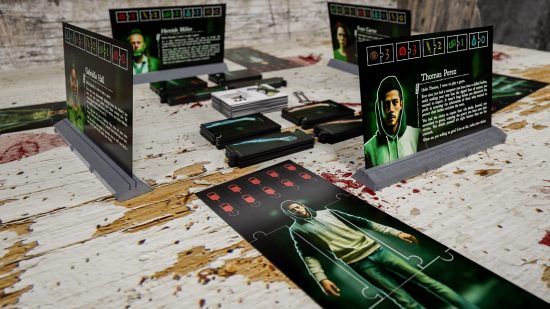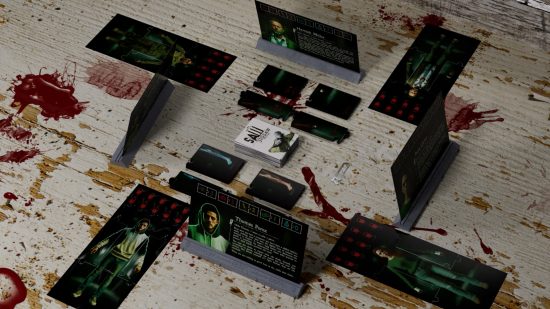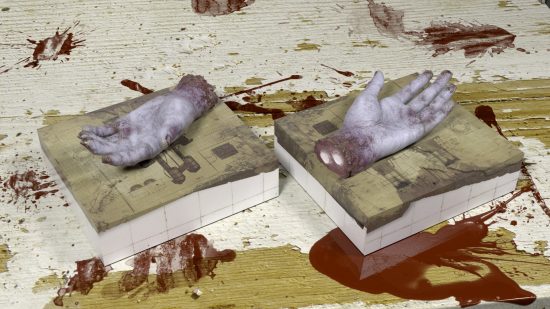Whether you love or loathe its gory traps and outlandish plot twists, the Saw franchise transformed the horror genre when it released its first movie in 2004. Now, an official Saw board game is coming, with crowdfunding by developer Iconiq Studios currently underway.
As the first tabletop adaptation of the Saw movies, Saw: The Jigsaw Trials has some big, puppet-shaped shoes to fill. We spoke to Iconiq’s head of games development (who is also a big Saw fan and the Saw board game’s designer) Luke Melia to learn more. Our interview had all the features of a great Saw movie – gore, body parts, copycat killers, and over 2,000 grisly traps that command you to live or die. Make your choice.

WG: Can you tell me about the game’s core mechanics and how you developed them?
LM: There are a lot of different ways you could do a Saw game. We could have had an asymmetrical game where one person is Jigsaw and everybody else is trying to survive – but sometimes with games like that, you end up in a situation where it’s a lot more fun for one person than it is for everybody else. So I wanted to create a game where everybody is Jigsaw and a victim at the same time.
Throughout the film series, Jigsaw was always looking for a successor. He goes through several different people that he attempts to mold so they can take over his role. So my concept [for the board game] was that he captures six people, all of them slightly different from his normal victims because they have the potential to do good – but something went wrong along the way. Jigsaw believes through his trials, he can steer them back to the right path.
Mechanically, this meant coming up with a way [players] can build traps by combining parts. And it’s not just about who can make the best trap – it’s who can make the best trap for a specific person, tailoring the trap to their opponent’s personal stories.
For me personally, the thing I’m most proud of is the way the trap stories align. You build a trap out of three parts. The central idea is there are core [character] traits at play – addiction, corruption, obsession, violence, and greed – and every trap part is aimed at one or two of these. When you put the parts together, they create a story you can read, and that story changes according to the parts you choose.
There are over 2,000 combinations. I created a spreadsheet where every time I pressed Enter, it created a new random story so that I could check that they always worked.
Was it challenging to recreate the tension and horror of the movies in board game form? How did you address this challenge?
There were two different aspects of that – one was to make sure we captured the bloody gore effects of Saw, and the other one was to try and capture the tension and horror.
The blood and gore came from our Jigsaw damage system. Every character has a full Jigsaw system where they’ve got their torso and head as one piece, and then each arm and leg is a separate piece. As they take damage, you replace these pieces with X-ray versions of the arm or leg.
And then, if [the limb] takes too much [damage], you change it to a grisly, lost limb that’s bleeding out. Everyone has blood tokens, and you start to see your blood drop as you bleed out.
Once you start seeing those limbs change, all of a sudden the tension kicks in. Every time someone produces a Billy card and says they want to play a game, you’re begging [the trap they’re setting] is not for you.
Were there any existing games you took inspiration from or tried to differentiate from? You mentioned not wanting to do an asymmetric game, which is quite a popular choice for horror board games. But other parts of the game are very similar to existing horror board games – like Grindhouse, for example.
Okay, so I had never heard of Grindhouse. But we did Essen Spiel this year for the first time, and somebody there told me about it. And I was a little bit gutted because I thought our Jigsaw damage system was something unique and new, but Grindhouse has a similar mechanic where characters lose limbs and swap pieces out.

[During design] I tried not to look too much at what else was out there so I wouldn’t be influenced or put off by it. You can get into an impossible situation where, if you consider everything, it feels like everything’s already been done.
So I looked [at existing games] at first and didn’t see anything too similar. I now know that Grindhouse exists, but outside of that, I haven’t seen any [games] too similar yet.
How involved were Lionsgate and Twisted Pictures with the board game? Did they have any notes for you?
Lionsgate and Twisted Pictures are obviously huge companies, so I thought they’d be a lot more hands-off than they were. I figured they’d leave us to it and check out the end result, but they were interested the whole way through – and it’s a better game because of that.
They weren’t really involved with the mechanics and gameplay, but in terms of narrative they really were. When I sent my first character descriptions and writing, they came back with a whole bunch of ideas and little things we could do to improve, as well as alternative ideas for stories that’d feel slightly more Saw. They also had some involvement with [development of] the general themes.
Tell me the story behind the severed hand – why did it become your game’s central image (and enormous miniature)?
We were thinking about [crowdfunding add-ons], and we didn’t want it to be something to do with gameplay. We wanted everybody who buys the game to get everything they need [to play]. So we were thinking of something that could be included as a collector’s item, and the head of Iconiq Studios came up with the idea of recreating the hand from the front of the game box.
The game box art was inspired by all the old Saw posters, which tend to involve a lost limb or body part and tell a bit of a story about what’s going on in the film. In this case, we have somebody mapping out the blueprints of a trap and their hand has been cut off. The underside of the Collector’s Edition box has that trap printed on it so you can use the hand to recreate the box art.
[The hand] doesn’t really have a gameplay purpose, but I’ve been swapping the game’s metal saw token out for the hand. When you’re set a trap, you use the saw token to show you can’t be trapped next so you’re not constantly being targeted. The hand fits nicely in front of your workbench, just waving at everyone who can’t attack you next.
Saw: The Jigsaw Trials is crowdfunding on Kickstarter until November 30. For more on the best board games, check out the Black Friday board game deals we’ve scouted ahead of time. And for more scares, check out our favorite horror board games.
